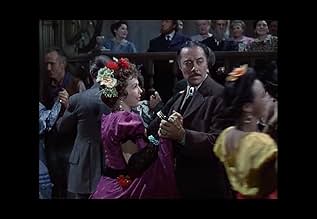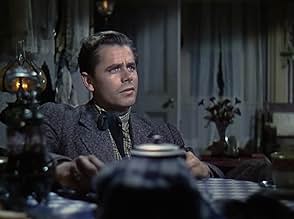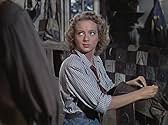IMDb रेटिंग
6.4/10
1.8 हज़ार
आपकी रेटिंग
अपनी भाषा में प्लॉट जोड़ेंA wanted outlaw arrives in town to rob a bank that has already been held up! His past and his friendship with the sheriff land them both in trouble.A wanted outlaw arrives in town to rob a bank that has already been held up! His past and his friendship with the sheriff land them both in trouble.A wanted outlaw arrives in town to rob a bank that has already been held up! His past and his friendship with the sheriff land them both in trouble.
Guinn 'Big Boy' Williams
- Nitro Rankin
- (as Guinn {Big Boy} Williams)
Irving Bacon
- Dan Walters
- (बिना क्रेडिट के)
Hank Bell
- Poker Player
- (बिना क्रेडिट के)
Chris Willow Bird
- Indian
- (बिना क्रेडिट के)
Edgar Caldwell
- Townsman
- (बिना क्रेडिट के)
Chester Clute
- Rollo
- (बिना क्रेडिट के)
Tex Cooper
- Townsman
- (बिना क्रेडिट के)
Victor Cox
- Juror
- (बिना क्रेडिट के)
फ़ीचर्ड समीक्षाएं
"The Desperadoes" (1943) is a genuine classic, not for its story (which is fairly routine), but for its technical production elements. This was a landmark western, the biggest ever at the time of its release and all the more unique because it was a Columbia production-a lightweight studio with a bottom feeding reputation. Only Fox's "Jesse James" (also starring Randolph Scott) from a few years earlier gave anywhere near this lavish a treatment to the genre. Although it would be eclipsed in a few years by "The Searchers" and "High Noon", "The Desperadoes" was a ground breaking effort and a historical treasure.
In 1863, the economy in the town of Red Valley, Utah is based on rounding up and selling wild horses to the Union Army. The script gets a little messed up here with references to the railroad (which was several years away in Utah's future) and Custer's Last Stand (Custer was busy fighting Stuart in Pennsylvania at the time) but these are not important plot elements.
Red Valley has an honest sheriff, Steve Upton (Scott), but the banker and several citizens are corrupt; robbing their own bank each time the government pays for a herd of horses. The town is visited by Cheyenne Rogers (Glenn Ford), a famous outlaw who is an old friend Steve's. He wants to go straight, especially after falling for the pretty livery stable owner Alison McLeod (Evelyn Keyes). Cheyenne's partner "Nitro" Rankin (Guinn "Big Boy" Williams) is mainly there for comic relief as are Uncle Willie McLeod (Edgar Buchanan) and the town judge (Raymond Walburn who models his character on Frank Morgan's "Wizard of Oz" crystal ball faker).
Taking no chances with their huge budget Columbia packed this thing with tons of action and every western movie element but Indians and covered wagons. There is the best wild horse stampede ever filmed, a spectacular barroom brawl, an explosive climax, romance, and three-strip Technicolor. All this stuff doesn't necessarily fit together but who would have cared back in 1943. Unity is a problem as it tries to be both a serious action western and a comedy.
The cinematography was probably the best ever at the time of its filming. The indoor scenes are solid but it is the naturalistic outdoor photography that is truly impressive; both the lyrical static shots and the moving camera filming of the action sequences.
Scott and Claire Trevor were top billed, but the studio clearly wanted to promote Ford, who would soon be their biggest star. And Director Charles Vidor utilized the film to showcase his new wife Keyes (whose portrayal of Scarlett's sister in "Gone With the Wind" had connected with audiences more than any small part in the history of films).
The Ford-Keyes dynamic is "The Desperadoes" most unique and important feature. Rather than go for the cliché "love triangle" with Scott and/or Trevor (which it first appears will happen), the entire romantic focus is on the two younger actors. This was probably the best role Keyes ever got and she makes the most of it. Playing a tomboyish but extremely sexy young woman who looks great in both leather pants and dresses, and who rides and fights like Kiera Knightley's character in "Pirates of the Caribbean". This was revolutionary at the time and coincided with the 1942 formation of the WAAC for WWII military service.
"The Desperadoes" is one film that has been well taken care of and the print looks like it is brand new. Unfortunately there are no special features on the DVD.
Then again, what do I know? I'm only a child.
In 1863, the economy in the town of Red Valley, Utah is based on rounding up and selling wild horses to the Union Army. The script gets a little messed up here with references to the railroad (which was several years away in Utah's future) and Custer's Last Stand (Custer was busy fighting Stuart in Pennsylvania at the time) but these are not important plot elements.
Red Valley has an honest sheriff, Steve Upton (Scott), but the banker and several citizens are corrupt; robbing their own bank each time the government pays for a herd of horses. The town is visited by Cheyenne Rogers (Glenn Ford), a famous outlaw who is an old friend Steve's. He wants to go straight, especially after falling for the pretty livery stable owner Alison McLeod (Evelyn Keyes). Cheyenne's partner "Nitro" Rankin (Guinn "Big Boy" Williams) is mainly there for comic relief as are Uncle Willie McLeod (Edgar Buchanan) and the town judge (Raymond Walburn who models his character on Frank Morgan's "Wizard of Oz" crystal ball faker).
Taking no chances with their huge budget Columbia packed this thing with tons of action and every western movie element but Indians and covered wagons. There is the best wild horse stampede ever filmed, a spectacular barroom brawl, an explosive climax, romance, and three-strip Technicolor. All this stuff doesn't necessarily fit together but who would have cared back in 1943. Unity is a problem as it tries to be both a serious action western and a comedy.
The cinematography was probably the best ever at the time of its filming. The indoor scenes are solid but it is the naturalistic outdoor photography that is truly impressive; both the lyrical static shots and the moving camera filming of the action sequences.
Scott and Claire Trevor were top billed, but the studio clearly wanted to promote Ford, who would soon be their biggest star. And Director Charles Vidor utilized the film to showcase his new wife Keyes (whose portrayal of Scarlett's sister in "Gone With the Wind" had connected with audiences more than any small part in the history of films).
The Ford-Keyes dynamic is "The Desperadoes" most unique and important feature. Rather than go for the cliché "love triangle" with Scott and/or Trevor (which it first appears will happen), the entire romantic focus is on the two younger actors. This was probably the best role Keyes ever got and she makes the most of it. Playing a tomboyish but extremely sexy young woman who looks great in both leather pants and dresses, and who rides and fights like Kiera Knightley's character in "Pirates of the Caribbean". This was revolutionary at the time and coincided with the 1942 formation of the WAAC for WWII military service.
"The Desperadoes" is one film that has been well taken care of and the print looks like it is brand new. Unfortunately there are no special features on the DVD.
Then again, what do I know? I'm only a child.
Blimey, this movie is nearly 60 years old. As it's filmed in "glorious technicolour" it gives it a much more modern feel. The story is of some 'insider trading' at the local bank and the need to bring those responsible to justice.
There are some fine performances throughout and the mix of drama and comedy (featuring great stuff from 'Nitro' and the bartender) is spot on. The story is a good one and it is entertaining from start to finish. Definitely a superior Western.
There are some fine performances throughout and the mix of drama and comedy (featuring great stuff from 'Nitro' and the bartender) is spot on. The story is a good one and it is entertaining from start to finish. Definitely a superior Western.
... and that's a rarity during this particular year, but perhaps more likely in a western such as this.
Although Randolph Scott and Claire Trevor get top billing, they are actually second leads. Top leads go to the second-billed couple, a young and startlingly luxuriously-pated Glenn Ford along with Evelyne Keyes in leather pants. Ford is not quite as noxious as he would later become on-screen; he makes an effective "good bad man", as Keyes refers to him.
Randolph Scott basically grins his way through the story of a sheriff, Ford, and Keyes busting the corrupt banker who has arranged for his own bank to be robbed. Trevor doesn't get much to do as the local madam. Guinn "Big Boy" Williams provides good comic relief as Ford's loyal sidekick, and Edgar Buchanan is wonderful as the morally wavering "town uncle" whose own corruption is incomplete because of his paternal worrying over daughter Keyes.
The story may be rote, but the script is excellent, the direction is efficient, and there are some scenery shots that are actually "new", such as from-above shots of a very narrow path cut through a rocky hill. This is a good film, not just a good Western.
Although Randolph Scott and Claire Trevor get top billing, they are actually second leads. Top leads go to the second-billed couple, a young and startlingly luxuriously-pated Glenn Ford along with Evelyne Keyes in leather pants. Ford is not quite as noxious as he would later become on-screen; he makes an effective "good bad man", as Keyes refers to him.
Randolph Scott basically grins his way through the story of a sheriff, Ford, and Keyes busting the corrupt banker who has arranged for his own bank to be robbed. Trevor doesn't get much to do as the local madam. Guinn "Big Boy" Williams provides good comic relief as Ford's loyal sidekick, and Edgar Buchanan is wonderful as the morally wavering "town uncle" whose own corruption is incomplete because of his paternal worrying over daughter Keyes.
The story may be rote, but the script is excellent, the direction is efficient, and there are some scenery shots that are actually "new", such as from-above shots of a very narrow path cut through a rocky hill. This is a good film, not just a good Western.
Highly enjoyable Western with better than average character twists. Columbia was never a big-budget studio like MGM or TCF. But they did like Westerns. So it's not surprising Columbia got into Technicolor with this scenic, well-produced horse opera. Looks like they were angling for the broadest possible audience with not one leading lady, but two (Keyes & Trevor). Ditto with the leading men (Scott & Ford). Add the great Edgar Buchanan in the kind of slippery role he did so well, plus the hulking Big Boy Williams and blowhard Raymond Walburn, and you've got an excellent supporting cast.
It's a really entertaining mix of action, shifting loyalties, humor, plus a dash of romance. The plot's a little shopworn—two old friends find themselves on opposite sides of the law, but the rivalry is well done. Several scenes are standouts—the wild horse stampede nicely framed against the dramatic Utah background, the judge's comical idea of frontier justice, and the tongue-in- cheek barroom brawl. All in all, director Vidor blends the many different elements into a pretty smooth package.
I may be wrong, but I don't think many A-budget Westerns were produced during WWII. Action films were generally war films promoting the Allies cause. This movie, I think, is one of the few elaborate oaters of the period. And a good one it still is.
It's a really entertaining mix of action, shifting loyalties, humor, plus a dash of romance. The plot's a little shopworn—two old friends find themselves on opposite sides of the law, but the rivalry is well done. Several scenes are standouts—the wild horse stampede nicely framed against the dramatic Utah background, the judge's comical idea of frontier justice, and the tongue-in- cheek barroom brawl. All in all, director Vidor blends the many different elements into a pretty smooth package.
I may be wrong, but I don't think many A-budget Westerns were produced during WWII. Action films were generally war films promoting the Allies cause. This movie, I think, is one of the few elaborate oaters of the period. And a good one it still is.
Ladies and gentlemen, is the daily grind getting you down? Do you want a good, old-fashioned oater to fill in the early evening hours? Well, it's all here for you folks in Charles Vidor's 1943 production "The Desperadoes".
You've got your stalwart lawman (Randolph Scott), your good bad guy (Glenn Ford), the spunky romantic interest (Evelyn Keyes), the tough but tender saloon hostess (Claire Trevor) and the not-too-bright sidekick (Guinn "Big Boy" Williams). You've got gorgeous Technicolor, stampedes, bronco riding, shady businessmen and an explosion or two! So, pop that corn and melt that butter. What's that? You want more, folks? You want scene stealers? Well, seeing as it's you, we have two of the greatest. Mr. Edgar Buchanan and Mr. Raymond Walburn will commit grand larceny before your very eyes.
So, sit back and relax, ladies and gentlemen. It's all here!
You've got your stalwart lawman (Randolph Scott), your good bad guy (Glenn Ford), the spunky romantic interest (Evelyn Keyes), the tough but tender saloon hostess (Claire Trevor) and the not-too-bright sidekick (Guinn "Big Boy" Williams). You've got gorgeous Technicolor, stampedes, bronco riding, shady businessmen and an explosion or two! So, pop that corn and melt that butter. What's that? You want more, folks? You want scene stealers? Well, seeing as it's you, we have two of the greatest. Mr. Edgar Buchanan and Mr. Raymond Walburn will commit grand larceny before your very eyes.
So, sit back and relax, ladies and gentlemen. It's all here!
क्या आपको पता है
- ट्रिवियाThis was Columbia's first Technicolor feature.
- गूफ़When the new safe for the bank arrives Uncle Willie McLeod says it's "built like a battleship." The story takes place in 1863. The term "battleship" did not come into wide use until the late 1880s.
- भाव
Jack Lester: Cheyenne, you ain't serious, are you? Killin' me don't make sense.
Nitro Rankin: [sarcasticly] It never does to the fella that's getting killed.
- क्रेज़ी क्रेडिटOpening and closing credits: 1863 - the newest frontier was Utah - Utah's gold was its wild horses, which the Union Army was seeking to buy. Men rushed to this new frontier - some to break these horses - others to break the law.
- कनेक्शनEdited into The Doolins of Oklahoma (1949)
टॉप पसंद
रेटिंग देने के लिए साइन-इन करें और वैयक्तिकृत सुझावों के लिए वॉचलिस्ट करें
- How long is The Desperadoes?Alexa द्वारा संचालित
विवरण
- चलने की अवधि
- 1 घं 27 मि(87 min)
- रंग
- पक्ष अनुपात
- 1.33 : 1
इस पेज में योगदान दें
किसी बदलाव का सुझाव दें या अनुपलब्ध कॉन्टेंट जोड़ें



































